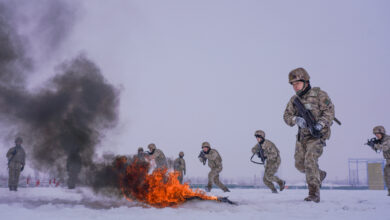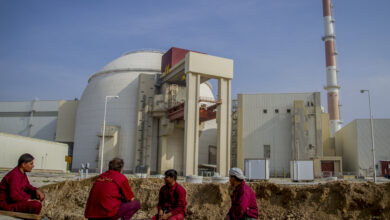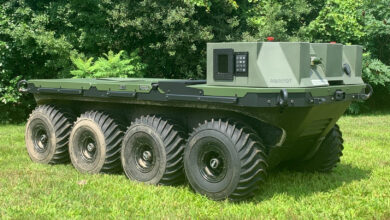
The recent G7 meeting in Europe fostered telling discussions between President Joe Biden and his NATO allies. Still, none were more meaningful than the agreement that China’s threat and aggressive behavior in the Indo-Pacific region must be challenged.
It’s no secret that China’s navy has experienced rapid growth over the past 15 years. From 2013 through 2015, Beijing aggressively undermined regional stability with its island-building on the Spratly and Paracel Islands in the South China Sea.
President Donald Trump’s Defense Department responded with a show of strength. It was aggressive in establishing overflight missions of these islands along with regular “freedom of navigation” patrols around the islands and through the Taiwanese Strait.
When Trump’s fourth Secretary of the Navy Kenneth J. Braithwaite II arrived, he quickly pulled together a small working group of the navy leadership. Together they developed the Future Navy Force Study (FNFS), a blueprint for funding and building a larger navy to challenge the China threat.
His plan was approved, and Secretary Mark Esper committed additional budget dollars to the navy.
Reactivating the First Fleet
Braithwaite testified before the Senate Armed Services subcommittee about FNFS, including his decision to reactivate the First Fleet disestablished 50 years ago. This new fleet would strengthen the American military resolve in the Indo-Pacific theater.
“This will reassure our allies and partners of our presence and commitment to this region…while ensuring any potential adversary will know we are committed to global presence to ensure rule of law and freedom of the seas,” Braithwaite stated.
In testifying about the new fleet, he indicated it would cover the western Pacific and the Eastern Indian Ocean. Braithwaite mentioned several countries as possible locations for the new fleet, including Japan, India, Australia, Singapore, Guam, and even the small island nation of the Republic of Palau.
Shortly after testifying, Braithwaite reconsidered his “homeport” concept and decided it should be an “expeditionary” force with no land-based headquarters. This would provide more unpredictability of an agile, mobile, at sea command positioned at the crossroads of the Indian and Pacific Oceans. It also underscored the need for strong foreign partnerships.
https://www.youtube.com/watch?v=6mZVn_f-jO8
Collaborating With Foreign-Owned Defense Contractors
While this effort started with NATO countries at the G7 who expressed a desire to partner militarily with the US in establishing a naval task force in the Indo-Pacific region, it does not end there.
Collaborating with our allies in Asia, as well as engaging in partnerships with foreign-owned defense contractors of allied nations, will help ensure America possesses the technological and defense capabilities necessary to confront China.
Partnerships with NATO-allied defense contractors such as the United Kingdom’s BAE Systems and France’s Thales have been commonplace for years and are a logical place to start.
Singapore meanwhile, mentioned by Braithwaite as a possible location for the First Fleet, is an example of how such relationships can be expanded in the increasingly competitive Asia-Pacific region.
ST Engineering, a Singaporean company building icebreaker ships for the US to confront geopolitical foes in the Arctic, is just one example of how we reply on an increasingly large circle of foreign suppliers to keep America’s military competitive.
Great Power Competition
Establishing a naval task force and partnership alongside new commercial alliances will provide more ships and personnel and ensure naval power projection to the region at exactly the right time.
The threat of invasion to Taiwan has accelerated, with some experts predicting that China is preparing to take Taiwan within the next six years. Meanwhile Russia, also not to be forgotten, recently conducted one of the largest military/naval exercises since the Cold War just 300 to 500 miles off the coast of Hawaii.
There should be no doubt; the era of “great power competition” is real and here to stay, and now is the time for action.
The proposed flat-line defense budget reduces the ability and size of the US Navy. The question is now what “level of risk” are the senior DOD leaders and congressional appropriators willing to take to protect our nation.
A commitment to building a larger navy with a combination of manned and unmanned vessels as well as partnering with foreign contractors to procure key technologies is critical to confront threats posed by Russia and China.
Actions speak louder than words, and the sense of urgency to confront America’s adversaries on the world stage has never been greater.
 Gregory J. Slavonic served as the acting Under Secretary of the Navy from April 24, 2020, until January 20, 2021, and was previously the 18th Assistant Secretary of the Navy for Manpower and Reserve Affairs. Prior to his time in the Department of the Navy, RADM Slavonic served as Chief of Staff for US Senator James Lankford (R-OK) and was his last chief when he was a member of the US House of Representatives.
Gregory J. Slavonic served as the acting Under Secretary of the Navy from April 24, 2020, until January 20, 2021, and was previously the 18th Assistant Secretary of the Navy for Manpower and Reserve Affairs. Prior to his time in the Department of the Navy, RADM Slavonic served as Chief of Staff for US Senator James Lankford (R-OK) and was his last chief when he was a member of the US House of Representatives.
Mr. Slavonic retired from the US Navy/Navy Reserve after a 34-year career. He began by enlisting as a Seaman Recruit and concluded a distinguished career attaining the rank of Rear Admiral. During his Navy career he held four command assignments, served in combat deployments to Vietnam, Operations Desert Shield/Desert Storm, and Operation Iraqi Freedom. His final assignment was as the Navy’s sixth Special Assistant to Chief of Information and Director of Public Affairs Program (Reserve). His service awards include Bronze Star Medal (two awards), Legion of Merit Medal, Presidential Unit Citation, Combat Action Ribbon, and many other service and campaign medals.
The views and opinions expressed here are those of the author and do not necessarily reflect the editorial position of The Defense Post.
The Defense Post aims to publish a wide range of high-quality opinion and analysis from a diverse array of people – do you want to send us yours? Click here to submit an op-ed.











